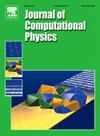求解四面体网格上双曲守恒律的越来越高阶ALW-MR-WENO格式
IF 3.8
2区 物理与天体物理
Q2 COMPUTER SCIENCE, INTERDISCIPLINARY APPLICATIONS
引用次数: 0
摘要
本文提出了在有限体积框架下求解四面体网格双曲守恒律的一种新的四阶多分辨率加权本质非振荡格式(称为MR-WENO-4格式)和具有自适应线性权重的MR-WENO-3和MR-WENO-4格式(称为ALW-MR-WENO-3和ALW-MR-WENO-4格式)。这是第一次在四面体网格上设计出三种越来越高阶的WENO方案,因为一种MR-WENO-4方案使用了四个不等大小的中心模板上定义的信息,而ALW-MR-WENO-3和ALW-MR-WENO-4方案使用了两个不等大小的中心模板上定义的信息。与在四面体网格上使用16个四单元模板的经典三阶有限体积WENO方案(Zhang and Shu, 2009[53])相比,这些新的MR-WENO方案的主要优点是WENO过程的简单、高效和紧凑性,任意选择任何正线性权值而不考虑四面体网格的拓扑结构,在光滑区域具有理想的高阶精度。以及在强不连续点附近的非振荡性质。更重要的是,在设计高阶ALW-MR-WENO方案时,在满足一个简单的约束条件下,只有两个线性权值自动调整为任意正值。在四面体网格上,与原来的MR-WENO-3方案和新的MR-WENO-4方案相比,ALW-MR-WENO -4方案可节省约12% ~ 43%的CPU时间。本文章由计算机程序翻译,如有差异,请以英文原文为准。
Increasingly high-order ALW-MR-WENO schemes for solving hyperbolic conservation laws on tetrahedral grids
This paper proposes a new fourth-order multi-resolution weighted essentially non-oscillatory scheme (which is termed as the MR-WENO-4 scheme), and the new MR-WENO-3 and MR-WENO-4 schemes with adaptive linear weights (which are termed as the ALW-MR-WENO-3 and ALW-MR-WENO-4 schemes) in the finite volume framework for solving hyperbolic conservation laws on tetrahedral grids. It is the first time to devise three increasingly high-order WENO schemes on tetrahedral grids, since one MR-WENO-4 scheme uses the information defined on four unequal-sized central stencils, and the ALW-MR-WENO-3 and ALW-MR-WENO-4 schemes use the information defined on two unequal-sized central stencils. In comparison to the classical third-order finite volume WENO scheme (Zhang and Shu, 2009 [53]) that used the sixteen four-cell stencils on tetrahedral grids, the key benefits of these new MR-WENO schemes are their simplicity, efficiency, and compactness in the WENO processes, the arbitrary selection of any positive linear weights without considering the topological structures of the tetrahedral grids, the ideal high-order accuracies in smooth areas, and the non-oscillatory property in the vicinity of strong discontinuities. More importantly, only two linear weights are automatically adjusted to be arbitrarily positive values on condition that one simple restriction is satisfied when designing the high-order ALW-MR-WENO schemes. Finally, some numerical results are proposed to show the good efficiency of these ALW-MR-WENO schemes which save approximately 12%-43% CPU time in comparison to that of the original MR-WENO-3 scheme and the new MR-WENO-4 scheme on tetrahedral grids.
求助全文
通过发布文献求助,成功后即可免费获取论文全文。
去求助
来源期刊

Journal of Computational Physics
物理-计算机:跨学科应用
CiteScore
7.60
自引率
14.60%
发文量
763
审稿时长
5.8 months
期刊介绍:
Journal of Computational Physics thoroughly treats the computational aspects of physical problems, presenting techniques for the numerical solution of mathematical equations arising in all areas of physics. The journal seeks to emphasize methods that cross disciplinary boundaries.
The Journal of Computational Physics also publishes short notes of 4 pages or less (including figures, tables, and references but excluding title pages). Letters to the Editor commenting on articles already published in this Journal will also be considered. Neither notes nor letters should have an abstract.
 求助内容:
求助内容: 应助结果提醒方式:
应助结果提醒方式:


